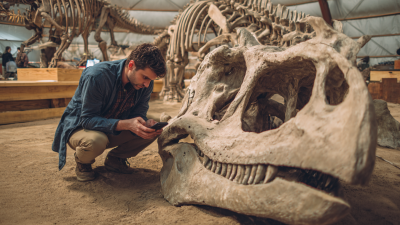How to Unearth Dinosaur Bones Like a Professional Paleontologist
Table of Contents
- Essential Tools Every Aspiring Paleontologist Should Have
- Understanding the Geological Context of Fossil Sites
- Field Techniques for Effective Dinosaur Bone Excavation
- Identifying and Preparing Dinosaur Fossils for Study
- Conserving and Displaying Your Fossil Finds Properly
- Collaborating with Museums and Researchers in Paleontology
- FAQS
- Conclusion
- Related Posts
The field of paleontology has long captivated the imaginations of both scientists and enthusiasts alike, with activities like "Dinosaur Bone Dig" serving as a gateway to uncovering the mysteries of our planet's prehistoric past. According to the American Society of Naturalists, interest in paleontology has surged over the last decade, with educational programs incorporating fossil hunting becoming increasingly popular worldwide. Jinhua City Dukoo Toys Co., Ltd. has been at the forefront of this trend since its inception in 2009, specializing in the creation of customizable archaeological toys that inspire a passion for discovery among young explorers. As the company has expanded from a modest 400 square meters to an impressive 8000 square meters, it reflects a growing market that values hands-on learning experiences. With our commitment to innovation and quality, Dukoo Toys is poised to contribute significantly to the educational toy sector, helping to nurture the next generation of paleontologists through engaging and informative "Dinosaur Bone Dig" experiences.

Essential Tools Every Aspiring Paleontologist Should Have
Unearthing dinosaur bones requires not just passion, but also the right tools vital for aspiring paleontologists. Essential equipment includes geological hammers, brushes, and hand drills, which are fundamental in carefully extracting fossils without causing damage. According to a report from the American Geosciences Institute, proper fieldwork tools can significantly influence the quality of fossil recovery, emphasizing the need for beginners to invest in quality gear. A good pair of field boots and a sturdy backpack for carrying supplies are also indispensable for long excavation sessions.
Additionally, paleontologists often use GPS devices and mapping software to document fossil localities accurately. This documentation is crucial for future research and conservation efforts. Recent studies underscore the importance of maintaining detailed records of fossil sites, particularly in national parks, where environmental changes can threaten these geological treasures. As the field of paleontology continues to grow, equipping oneself with the right tools and knowledge will ensure a strong foundation for any aspiring professional in this fascinating domain.
Understanding the Geological Context of Fossil Sites
Understanding the geological context of fossil sites is essential for anyone aspiring to unearth dinosaur bones like a professional paleontologist. Fossils are not randomly scattered across the earth; they are often found in sedimentary rock layers that have formed over millions of years. To effectively locate these treasures, one must study the geological formations surrounding potential fossil sites. This involves analyzing the types of rock present, the history of geological processes such as erosion and sedimentation, and the specific environmental conditions that prevailed when the organisms lived.
In addition to sedimentary layers, paleontologists must consider the stratigraphy of the area, which provides critical information about the relative ages of rock layers. Understanding how different layers relate to one another allows paleontologists to identify the most promising locations where dinosaur bones are likely to be preserved. Fossils tend to be concentrated in specific 'horizons' within these layers, often linked to unique events such as floods or volcanic eruptions that favored fossilization.
By integrating geological knowledge with fieldwork, aspiring paleontologists can increase their chances of successful discoveries, ensuring their excavation efforts are both efficient and scientifically valuable.
Field Techniques for Effective Dinosaur Bone Excavation
Excavating dinosaur bones like a professional paleontologist involves mastering a series of field techniques essential for effective fossil retrieval. First and foremost, proper preparation is crucial. Paleontologists must be equipped with tools such as chisels, brushes, and sometimes even more advanced technology. The goal is to carefully expose the fossil without damaging it, often requiring meticulous work to remove the surrounding rock. Understanding the geology of the dig site can significantly enhance one’s chances of finding valuable specimens.

For aspiring fossil hunters, here are a few tips to keep in mind:
- Focus your search in areas with known geological formations that could reveal fossils;
- Research your location to understand what types of fossils are commonly found;
- Always carry a field guide to help identify potential finds.
Finally, maintaining patience and persistence is key. Fossil hunting can be physically demanding and mentally challenging, but the thrill of discovery makes all the effort worthwhile. Whether you're digging in North Dakota or combing beaches for prehistoric remnants, each step in the excavation process brings you closer to uncovering the secrets of dinosaurs lost to time.
Identifying and Preparing Dinosaur Fossils for Study
Identifying and preparing dinosaur fossils for study requires a keen eye, patience, and a methodical approach akin to that of professional paleontologists. Tools like CT segmentation have emerged as innovative methods for efficiently analyzing fossil structures. A recent study demonstrated that deep learning algorithms could effectively segment protoceratopsian fossils, potentially reducing the manual labor involved in fossil preparation by a significant margin. Such advancements hold considerable promise for enhancing our understanding of these ancient creatures.

Moreover, the identification of new dinosaur species, such as the recent discovery of a Late Cretaceous ankylosaur in East China, showcases the importance of thorough fossil examination and documentation. This fossil was uncovered nearly four decades ago, yet only now has it been classified as a distinct species, highlighting the meticulous nature of fossil preparation.
Furthermore, as evidenced by various discoveries worldwide—including the oldest sauropod in South China—persistent efforts in fossil identification unveil the complex history of dinosaurs and enrich our paleontological knowledge. Overall, the intersection of technology and traditional fossil study continues to drive the field forward, revealing the rich tapestry of life that once inhabited our planet.
Conserving and Displaying Your Fossil Finds Properly
When unearthing dinosaur bones, proper conservation and display techniques are essential to preserve these precious fossils. After carefully excavating your finds, it's important to clean them gently using soft brushes to remove dirt and debris. Avoid using harsh chemicals, as they can damage the bones. Once cleaned, the fossils should be dried completely to prevent moisture-related decay.
Employing appropriate storage solutions is vital for maintaining your fossils. Use acid-free materials for wrapping and storing, and consider displaying them in a controlled environment with stable temperatures and humidity levels. This protects your fossils from environmental factors that could lead to deterioration.
At Jinhua City Dukoo Toys Co., Ltd., we have extensive experience in creating archaeological toys that inspire curiosity and education. Since 2009, we’ve dedicated ourselves to customizing archaeological products, catering to a global clientele. With our factory's growth from 400 to 8000 square meters, we continue to focus on delivering quality and fostering a deeper understanding of paleontology for enthusiasts and young explorers alike.
Collaborating with Museums and Researchers in Paleontology
Collaborating with museums and researchers is a vital component in the journey of unearthing dinosaur bones like a professional paleontologist. This collaboration not only provides access to extensive fossil collections but also exposes aspiring paleontologists to cutting-edge research techniques. Data from the American Association of Museums reveals that over 28,000 specimens are housed in U.S. museums alone, offering invaluable opportunities for hands-on training and mentorship. Partnering with established institutions can facilitate access to excavation sites and fossil preparation labs, helping individuals develop their skills in a professional setting.
Tips: When seeking collaboration, reach out to local universities and paleontological societies to explore internship opportunities. Engaging in volunteer work at museums can also lead to significant networking opportunities, allowing you to meet professionals in the field.
Utilizing resources from museum databases can amplify your research capabilities. According to a 2022 report by the Geological Society of America, collaborative projects led to significant findings that pushed the boundaries of our understanding of dinosaur biodiversity. By leveraging these partnerships, aspiring paleontologists can gain access to exclusive resources and datasets that are crucial for effective research and discovery in paleontology.
FAQS
: Aspiring paleontologists should have geological hammers, brushes, hand drills, GPS devices, mapping software, quality field boots, and a sturdy backpack for efficient fossil extraction and documentation.
Understanding the geological context is crucial because fossils are found in sedimentary rock layers formed over millions of years. Analyzing these layers helps locate promising fossil sites and enhances the chances of successful discoveries.
Stratigraphy provides information about the relative ages of rock layers, helping paleontologists identify specific horizons where fossils are likely to be preserved.
Technologies like CT segmentation and deep learning algorithms have made it possible to analyze and prepare fossils more efficiently, reducing manual labor and enhancing understanding of fossil structures.
The classification of a Late Cretaceous ankylosaur from nearly four decades ago shows that thorough examination and documentation are key to identifying new dinosaur species.
Accurate documentation of fossil localities is vital for future research and conservation efforts, especially in areas like national parks where environmental changes may threaten fossil sites.
Fossils often concentrate in particular horizons linked to unique geological events, which indicates the conditions that favored fossilization and can guide paleontologists in their research.
By integrating geological knowledge with field techniques and investing in essential tools, aspiring paleontologists can optimize their excavation processes and improve the quality of their fossil recovery.
Ongoing efforts in fossil identification, such as the discovery of the oldest sauropod, showcase the complex history of dinosaurs and contribute to a deeper understanding of their evolution.
Environmental changes can threaten fossil sites, making it critical to maintain detailed records and documentation for conservation and future research initiatives.
Conclusion
In "How to Unearth Dinosaur Bones Like a Professional Paleontologist," the article provides a comprehensive guide for aspiring paleontologists eager to engage in dinosaur bone dig activities. It emphasizes the essential tools required, such as excavation equipment and safety gear, to ensure a successful excavation experience. Understanding the geological context of fossil sites is crucial, as this knowledge aids in identifying promising dig locations.
The article further highlights field techniques for effective excavation, followed by methods for identifying and preparing dinosaur fossils for study. Proper conservation and display practices are also discussed, ensuring that finds are preserved for future generations. Lastly, collaboration with museums and other researchers is encouraged to enhance learning and contribute to the field of paleontology, fostering a deeper appreciation for these ancient creatures.
Related Posts
-

The Future of Interactive Dinosaur Bone Dig Experiences
-

How to Choose the Best Digging Toys for Your Child's Outdoor Adventures
-

Ultimate Guide to Sourcing Multi-Player Dig Adventure Games for Global Markets
-

How to Unlock the Secrets of Fossil Discovery Toy for Young Explorers
-

7 Creative Tips for Maximizing Fun with Parent-child Educational Dig Toys
-

10 Essential Tips for Creating the Perfect Outdoor Dig Pit for Kids
Blog Tags:

